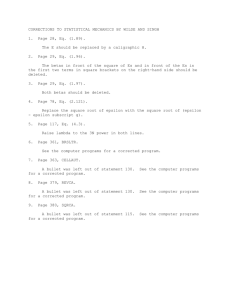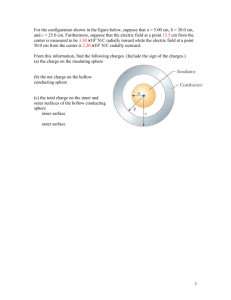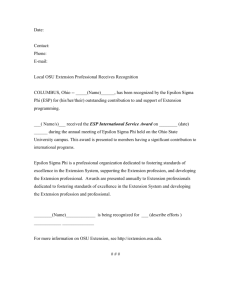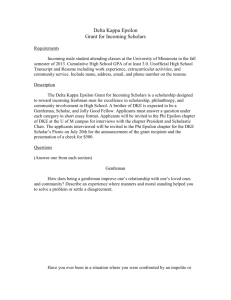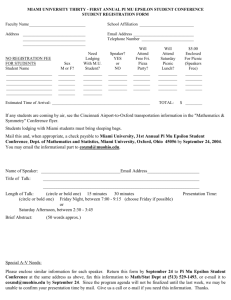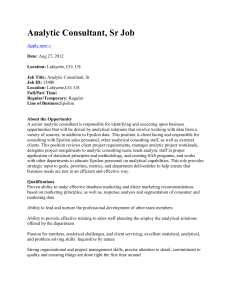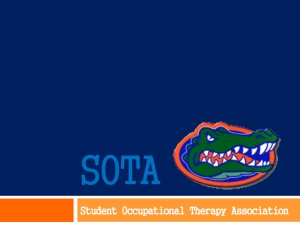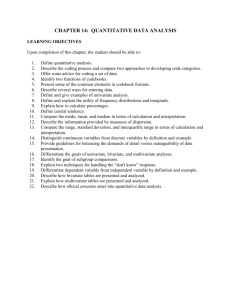Three- way ANOVA
advertisement
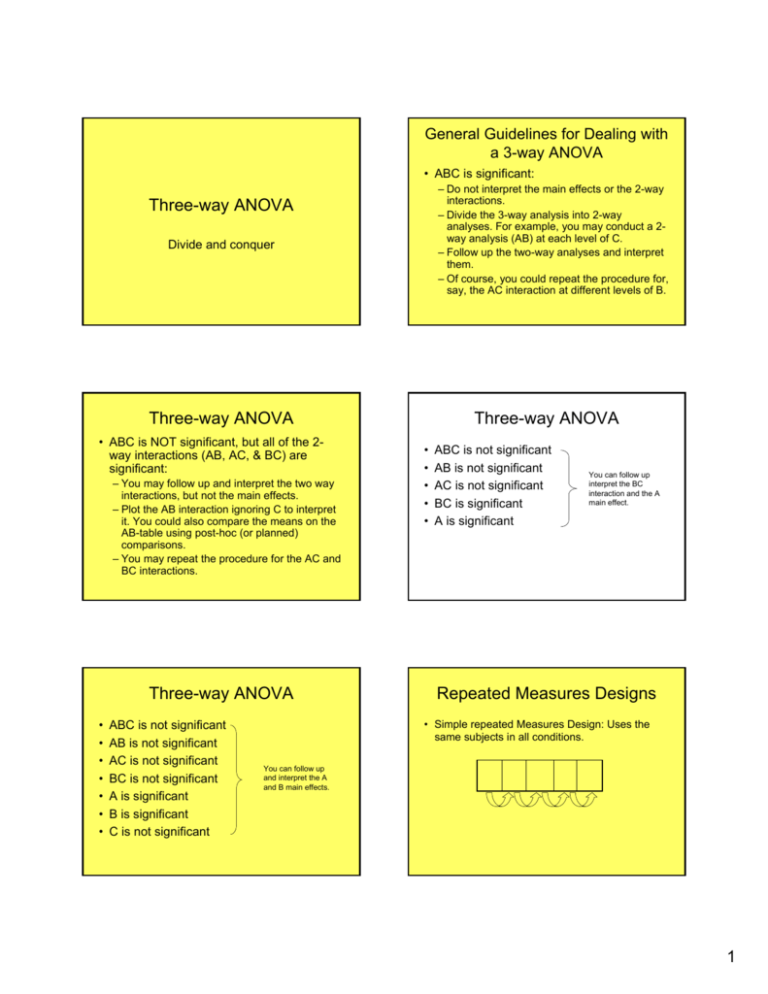
General Guidelines for Dealing with a 3-way ANOVA • ABC is significant: – Do not interpret the main effects or the 2-way interactions. – Divide the 3-way analysis into 2-way analyses. For example, you may conduct a 2way analysis (AB) at each level of C. – Follow up the two-way analyses and interpret them. – Of course, you could repeat the procedure for, say, the AC interaction at different levels of B. Three-way ANOVA Divide and conquer Three-way ANOVA • ABC is NOT significant, but all of the 2way interactions (AB, AC, & BC) are significant: – You may follow up and interpret the two way interactions, but not the main effects. – Plot the AB interaction ignoring C to interpret it. You could also compare the means on the AB-table using post-hoc (or planned) comparisons. – You may repeat the procedure for the AC and BC interactions. Three-way ANOVA • • • • • • • ABC is not significant AB is not significant AC is not significant BC is not significant A is significant B is significant C is not significant Three-way ANOVA • • • • • ABC is not significant AB is not significant AC is not significant BC is significant A is significant You can follow up interpret the BC interaction and the A main effect. Repeated Measures Designs • Simple repeated Measures Design: Uses the same subjects in all conditions. You can follow up and interpret the A and B main effects. 1 Simple Repeated Measures Design SAS Setup for a Simple Repeated Measures Design data repeated; input ss y1-y3; cards; 1 22 24 19 10 18 17 23 ; proc print; run; proc means;run; proc glm; model y1-y3= / nouni; repeated repfact 3; run; • The observations are not independent over conditions. • It is an extension of the correlated (or paired) t-test. • This analysis is also called a Within Design Multivariate Tests Means and Standard Dev. Variable N Mean Std Dev Minimum Maximum ss y1 y2 y3 10 10 10 10 5.500 17.500 18.900 22.400 3.0276 2.798 2.685 2.221 1.00 11.00 15.00 19.00 10.00 22.00 24.00 26.00 Manova Test Criteria and Exact F Statistics for the Hypothesis of no repfact Effect H = Type III SSCP Matrix for repfact E = Error SSCP Matrix S=1 M=0 N=3 Statistic Value F Value Num DF Den DF Pr > F Wilks' Lambda 0.421 5.49 2 8 0.0315 Pillai's Trace 0.578 5.49 2 8 0.0315 Hotelling-Lawley Trace 1.373 5.49 2 8 0.0315 Roy's Greatest Root 1.373 5.49 2 8 0.0315 The circularity assumption is not needed for the multivariate tests to be valid. Circularity Assumption is Met when epsilon is one Adj Pr > F Source DF Type III SS repfact 2 127.40 63.70 18 143.26 7.95 Error(repfact) Mean Square F Value Pr > F G-G H-F 8.00 0.0033 0.0052 0.0033 Greenhouse-Geisser Epsilon 0.8712 Huynh-Feldt Epsilon 1.0626 2 Epsilon More on Epsilon • Epsilon is a (sample) measure of how well the circularity assumption has been met. It ranges from 1/dfrep < ε < 1. In our previous example, the range is 1/2 < ε < 1. When epsilon is one, the circularity assumption has been met. If epsilon is 1/dfrep, circularity has been violated in a bad way. Adjusting the df’s in the Univariate F-tests • Usual F-test: use the usual dfs • a-1=2; (a-1)(s-1)=2*9=18; • df’s=2,18 • Conservative F-test (assume that ε=.5) • Then the df’s are 1 and 9. • F.05,2,18=3.55 F.05,1,9=5.12 • Epsilon corrected F-tests • Compute the sample epsilon and multiplied the dfs by this estimate. • If epsilon is not one, the usual univariate F-test must be adjusted. • When considering the univariate F-test we have three possibilities for adjusting the degrees of freedom: – Usual – Conservative – Adjusted Which Test is Best? • Multivariate test makes less assumptions but it is not always more powerful. • The e-adjusted test is a good alternative and can be more powerful than the multivariate tests. • Ordinarily we look at both tests. If both of them are significant, then report the one. • Never rely on the usual univariate F-test. Two-way ANOVA One Within and One Between • Lets say B is the within factor • And that A is the between factor B1 A1 A2 s1 sn1 sn1+1 sn2 B2 B3 F-test for the Groups by trials Source A B4 df F-test (a-1) S/A (error for A) (n-1)a B (b-1) B*A (b-1)(a-1) B*S/A (error for (b-1)(s-1)a B and B*A) 3 Weight Training Data • data wtsmiss; • input subj program$ s1 s2 s3 s4 s5 s6 s7; • datalines; • 1 CONT 85 85 86 85 87 • 2 CONT 80 79 79 78 78 • 3 CONT 78 77 77 77 76 • 4 CONT 84 84 85 84 83 • 5 CONT 80 81 80 80 79 • 6 CONT 76 78 77 78 78 • 7 CONT 79 79 80 79 80 • 8 CONT 76 76 76 75 75 • 9 CONT 77 78 78 80 80 • 10 CONT 79 79 79 79 77 SAS Setup for Groups by Trials 86 79 76 84 79 77 79 74 81 78 87 78 77 85 80 74 81 74 80 79 • /* Test of homogeneity of var-cov matrices for the Multivariate tests */ • proc discrim pool=test; • class program; • Var s1-s7; • run; • /* Obtainin the corrected univariate and multivariate tests */ • Proc glm data=wtsmiss; • class program; • model s1-s7= program / nouni; • repeated time 7 /printe summary; • means program; • run; Looking at the “Programs” • /* Running the simple main effect tests on the programs*/ • proc glm data=wtsmiss; • class program; • model s1-s7= program; • means program /tukey; • run; Assessing the Homogeneity Assumption Within Covariance Matrix Information Covariance Matrix Rank Natural Log of the Determinant of the Covariance Matrix CONT 7 0.40441 RI 7 2.06269 WI 7 -0.33541 Pooled 7 1.86089 program Interaction Effect The Chi-square Test Manova Test for the Hypothesis of no Time*program Effect H = Type III SSCP Matrix for time*program E = Error SSCP Matrix S=2 Chi-Square 55.863503 DF 56 M=1.5 N=23.5 Statistic Value F Value Num DF Den DF Pr > F Wilks' Lambda 0.7316 1.38 12 98 0.1880 Pillai's Trace 0.2818 1.37 12 100 0.1943 Hotelling-Lawley Trace 0.3481 1.40 12 73.199 0.1847 Roy's Greatest Root 0.2825 2.35 6 50 0.0442 Pr > ChiSq 0.4800 4 Time Effect Epsilon Manova Test Criteria and Exact F Statistics for the Hypothesis of no time Effect H = Type III SSCP Matrix for time E = Error SSCP Matrix S=1 M=2 N=23.5 Statistic Value F Value Num DF Den DF Pr > F Wilks' Lambda 0.5584 6.46 6 49 <.0001 Pillai's Trace 0.4415 6.46 6 49 <.0001 Hotelling-Lawley Trace 0.7905 6.46 6 49 <.0001 Roy's Greatest Root 0.7905 6.46 6 49 <.0001 Greenhouse-Geisser Epsilon 0.4233 Huynh-Feldt Epsilon 0.4624 Contrast Variable: time_4 Test of Circularity for the Repeated Factor Sphericity Tests Source DF Mauchly's Criterion Chi-Square Pr > ChiSq Transformed Variates 20 0.0009992 357.70745 <.0001 Orthogonal Components 20 0.0403737 166.18471 <.0001 Variables DF Type III SS Mean Square F Value Pr > F Mean 1 0.3792618 0.3792618 0.14 0.7093 program 2 10.7185464 5.3592732 1.98 0.1474 54 145.8428571 2.7007937 Error Univariate Tests: Time & Interaction Univariate Analysis: The Between Effect Adj Pr > F Source program Error DF Type III SS Mean Square F Value Pr > F Source D F 2 419.435 209.717631 3.07 0.0548 time 6 53.3542 8.8923 7.43 .0001 .0003 .0002 time*program 12 43.0002 3.5833 2.99 .0005 .0130 .0104 Error(time) 32 4 387.7867 1.1968 54 3694.690 68.420186 Type III SS Mean Square F Value Pr > F G-G H-F 5 Program Effect Contrast Variable: time_1 vs. Time_7 Source DF Type III SS Mean Square F Value Pr > F 2 419.435262 209.717631 3.07 0.0548 program Error 54 3694.690051 68.420186 Source DF Type III SS Mean Square F Value Pr > F Mean 1 69.4671822 69.4671 14.92 0.0003 program 2 51.9285401 25.9642 5.58 0.0063 54 251.4398810 4.6562 Error Contrast Variable: time_2 vs. Time_7 Source Contrast Variable: time_3 DF Type III SS Mean Square F Value Pr > F Mean 1 16.8194570 16.8194570 3.50 0.0669 program 2 32.4047306 16.2023653 3.37 0.0418 54 259.6303571 4.8079696 Error Source DF Type III SS Mean Square F Value Pr > F Mean 1 7.5978248 7.5978248 2.54 0.1168 program 2 26.0331767 13.0165883 4.35 0.0177 54 161.4755952 2.9902888 Error Repeated Factor Plot of Means T1 T2 T3 T4 T5 T6 T7 84 83 82 81 80 79 78 77 Between Wi Cont RI WI RI c ٧ A s/A 1 2 3 4 5 6 7 B ٧ BA ٧ B*s/A ٧ Simple Main Effects in Repeated Measures Designs 6 Simple Main Effect with Repeated Factors • When going across the repeated factor at a level of the between factor: Use the error term for the repeated factor. • When going across the between factor at a level of the within factor: Pool the between and within error terms. MS p = SS s / A + SS Bs / A df s / A + df Bs / A 7
